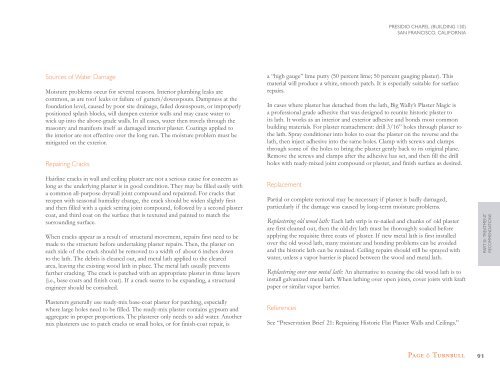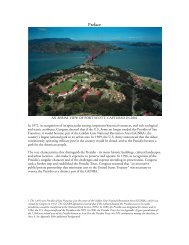Presidio Chapel Historic Structure Report - Presidio Trust
Presidio Chapel Historic Structure Report - Presidio Trust
Presidio Chapel Historic Structure Report - Presidio Trust
- No tags were found...
Create successful ePaper yourself
Turn your PDF publications into a flip-book with our unique Google optimized e-Paper software.
PRESIDIO CHAPEL (BUILDING 130)SAN FRANCISCO, CALIFORNIASources of Water DamageMoisture problems occur for several reasons. Interior plumbing leaks arecommon, as are roof leaks or failure of gutters/downspouts. Dampness at thefoundation level, caused by poor site drainage, failed downspouts, or improperlypositioned splash blocks, will dampen exterior walls and may cause water towick up into the above-grade walls. In all cases, water then travels through themasonry and manifests itself as damaged interior plaster. Coatings applied tothe interior are not effective over the long run. The moisture problem must bemitigated on the exterior.Repairing CracksHairline cracks in wall and ceiling plaster are not a serious cause for concern aslong as the underlying plaster is in good condition. They may be filled easily witha common all-purpose drywall joint compound and repainted. For cracks thatreopen with seasonal humidity change, the crack should be widen slightly firstand then filled with a quick setting joint compound, followed by a second plastercoat, and third coat on the surface that is textured and painted to match thesurrounding surface.When cracks appear as a result of structural movement, repairs first need to bemade to the structure before undertaking plaster repairs. Then, the plaster oneach side of the crack should be removed to a width of about 6 inches downto the lath. The debris is cleaned out, and metal lath applied to the clearedarea, leaving the existing wood lath in place. The metal lath usually preventsfurther cracking. The crack is patched with an appropriate plaster in three layers(i.e., base coats and finish coat). If a crack seems to be expanding, a structuralengineer should be consulted.Plasterers generally use ready-mix base-coat plaster for patching, especiallywhere large holes need to be filled. The ready-mix plaster contains gypsum andaggregate in proper proportions. The plasterer only needs to add water. Anothermix plasterers use to patch cracks or small holes, or for finish-coat repair, isa “high gauge” lime putty (50 percent lime; 50 percent gauging plaster). Thismaterial will produce a white, smooth patch. It is especially suitable for surfacerepairs.In cases where plaster has detached from the lath, Big Wally’s Plaster Magic isa professional grade adhesive that was designed to reunite historic plaster toits lath. It works as an interior and exterior adhesive and bonds most commonbuilding materials. For plaster reattachment: drill 3/16” holes through plaster tothe lath. Spray conditioner into holes to coat the plaster on the reverse and thelath, then inject adhesive into the same holes. Clamp with screws and clampsthrough some of the holes to bring the plaster gently back to its original plane.Remove the screws and clamps after the adhesive has set, and then fill the drillholes with ready-mixed joint compound or plaster, and finish surface as desired.ReplacementPartial or complete removal may be necessary if plaster is badly damaged,particularly if the damage was caused by long-term moisture problems.Replastering old wood lath: Each lath strip is re-nailed and chunks of old plasterare first cleaned out, then the old dry lath must be thoroughly soaked beforeapplying the requisite three coats of plaster. If new metal lath is first installedover the old wood lath, many moisture and bonding problems can be avoidedand the historic lath can be retained. Ceiling repairs should still be sprayed withwater, unless a vapor barrier is placed between the wood and metal lath.Replastering over new metal lath: An alternative to reusing the old wood lath is toinstall galvanized metal lath. When lathing over open joists, cover joists with kraftpaper or similar vapor barrier.ReferencesSee “Preservation Brief 21: Repairing <strong>Historic</strong> Flat Plaster Walls and Ceilings.”PART III: TREATMENTRECOMMENDATIONSPage & Turnbull91















